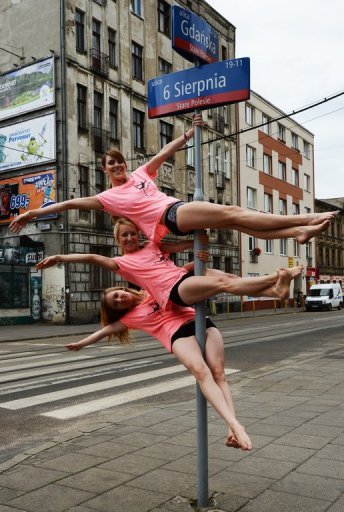
“It’s much easier in the studio. The poles are made of chromed steel, all smooth and easy on the hands,” said Drzymala, her palms powdered for traction.
Not so with signposts. Often old and rusty, with the paint chipping off, they can tear up a hand. They also vary in size, making it tricky to get a good grip.
Where the ideal diameter is four to five centimetres (1.6-2.4 inches), street poles are much thicker and rougher to boot.
“That’s why we go home with plenty of bruises all over” our bare hands and legs, said Kicinska, who has been pole-dancing for two years and now teaches it too.
Beyond Poland, urban pole-dancing has also cropped up in places ranging from the streets of Mexico City to the London underground, creating a stream of double-takes and gawking among the admiring public.
“They’re marvelous, really marvelous,” said onlooker Stanislawa Sztuc, a local retiree stopping to watch the Polish pole dancers on her way home from grocery-shopping.
“Acrobatics on signposts! Why not? It’s very original. It draws attention,” added student Konrad Chachula.
“But it could also be dangerous for drivers” who may get distracted, he said, his eyes glued to the smiling female safety hazards.
No problems yet, said Kicinska, who got a honk of approval from a fire truck while pretzeling herself around a signpost.
“We get really great reactions, people applaud and compliment us,” she said, adding that law enforcement had yet to take notice.
She spoke too soon, however. Within an hour the trio caught the eye of two young policemen who asked whether they had a permit to slide around on signposts.
“But we’re doing nothing wrong,” Kicinska protested. “We aren’t damaging the poles.”
Unmoved, the officers took down their names and issued a warning, cutting short their street show — just that day.
